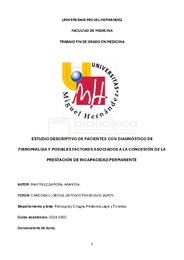Resumen :
Introducción: La fibromialgia (FM) es una de las principales causas de dolor crónico
generalizado que afecta principalmente a mujeres entre 30 y 50 años y que implica grandes
repercusiones sociales y económicas. Es una enfermedad compleja dado el escaso
conocimiento existente al respecto y a su manejo diagnóstico. La ausencia de marcadores
objetivos y su variabilidad clínica dificulta su valoración a nivel médico-legal, y, por tanto, la
concesión de la prestación de incapacidad permanente (IP) desde el ámbito judicial.
Resultados: Se ha estudiado una cohorte retrospectiva de 56 pacientes diagnosticados de
fibromialgia y valorados por un especialista en Medicina Legal y Forense. El 91,1% eran mujeres
con una media de 51 años y tiempo de diagnóstico de la enfermedad medio de 7 años. Las
manifestaciones clínicas más prevalentes fueron dolor generalizado y rigidez matutina (100%),
alteraciones del sueño (94,6%), afectación neurocognitiva (83,9%) y una alta comorbilidad
psiquiátrica principalmente con trastorno ansioso-depresivo (78,6%). En la mayoría de los
casos se requerían escalones superiores de analgesia; un 76,8% necesitaba opioides, un 50%
relajantes musculares y un 26,8% neuromoduladores. Se aprecia relación estadísticamente
significativa entre la severidad de la afectación neurocognitiva y la concesión de IP, así como
respecto al tiempo de evolución diagnóstica y grado de fibromialgia. También se detectaron de
forma casual asociaciones entre el sexo masculino y ciertas infecciones (como VEB, CMV,
VHS) o sensibilidad química múltiple, que puede ser interesante plantear de cara a estudios
futuros. Por otro lado, no hubo relación significativa entre la edad, síndrome de fatiga crónica,
ni seguimiento especializado respecto a la obtención de IP.
Conclusiones: El tiempo transcurrido desde el diagnostico de fibromialgia hasta su valoración
pericial es el factor más determinante a la hora de obtener la IP, sin embargo, también son
significativas el grado de fibromialgia, el uso de escalones analgésicos superiores como opioides y la gravedad de la afectación neurocognitiva. La presencia de trastornos
psiquiátricos concomitantes no es relevante respecto a la concesión de IP, pero sí lo es el
periodo de tiempo que transcurre desde el diagnóstico de estos.
Introduction: Fibromyalgia (FM) is one of the main causes of chronic widespread pain, mainly
akecting women between the ages of 30 and 50, with significant social and economic
repercussions. It is a complex disease given the limited knowledge available about it and its
diagnostic management. The absence of objective markers and its clinical variability make it
dikicult to assess from a medical-legal perspective and, therefore, to grant permanent
disability benefits from a legal standpoint.
Results: A retrospective cohort of 56 patients diagnosed with fibromyalgia and assessed by a
specialist in Legal and Forensic Medicine was studied. 91.1% were women with an average age
of 51 and an average diagnosis time of 7 years. The most prevalent clinical manifestations were
widespread pain and morning stikness (100%), sleep disorders (94.6%), neurocognitive
dysfunctions (83.9%) and high psychiatric comorbidity, mainly with anxiety-depressive
disorder (78.6%). In most cases, higher levels of analgesia were required; 76.8% needed
opioids, 50% muscle relaxants and 26.8% neuromodulators. A statistically significant
relationship was observed between the severity of neurocognitive impairment and the granting
of IP, as well as between the time of diagnosis and the degree of fibromyalgia. Casual
associations were also detected between male gender and certain infections (such as EBV,
CMV, HSV) or multiple chemical sensitivity, which may be interesting to consider in future studies. On the other hand, there was no significant relationship between age, chronic fatigue
syndrome or specialised follow-up about obtaining PI.
Conclusions: The time elapsed between the diagnosis of fibromyalgia and its expert
assessment is the most decisive factor in obtaining PI. However, the degree of fibromyalgia, the
use of higher analgesic steps such as opioids, and the severity of neurocognitive impairment
are also significant. The presence of concomitant psychiatric disorders is not relevant to the
granting of PI, but the time elapsed since their diagnosis is.
|
 La licencia se describe como: Atribución-NonComercial-NoDerivada 4.0 Internacional.
La licencia se describe como: Atribución-NonComercial-NoDerivada 4.0 Internacional.
.png)
